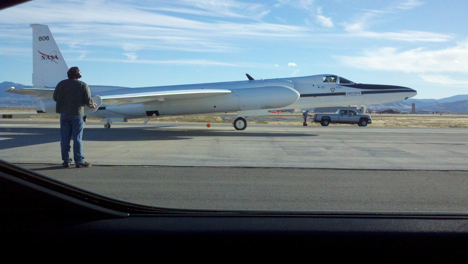MABEL flies aboard NASA’s ER-2, which is a research version of the Air Force’s U2 reconnaissance aircraft. MABEL specifically flies in the nose cone of the ER-2.
The ER-2 is special because it flies at a very high altitude. MABEL’s data is collected at approximately 65,000 feet above sea level, putting the instrument above much of the dense part of the atmosphere.
The ER-2 has 2 wheels, one behind the other, both running down the center of the aircraft (photos below). It takes off and lands with the assistance of ‘pogos’ on the ends of each wing. Pogos are temporary wheels that fall off immediately after take-off. When the plane lands, and slowly comes to a full stop, it generally tilts to one side or the other and rests on skids that are on the tip of each of the wings. Then the ground crew has to be manually reattached the pogos.


Flying at 65,000 feet above sea level, the pilots are in pressurized suits, much like astronauts. So the process of getting the pilot into the aircraft and off the ground takes longer than it would for other aircraft. The pilot actually comes to the aircraft in a life-support vehicle and carries with him a unit that helps bring him oxygen and keep him cool prior to takeoff (photos below).


To follow the ER-2, either with MABEL or on other missions, follow @NASA_airborne on Twitter.
More later about the ER-2 …




Must be an exelent glider with such a wingspan. What about Cosmic radiation at this level. How many mSie/hr vs Latitude is absorbed at that level?
What type of sensors does the plane carry for atmospheric observation and how do they work?